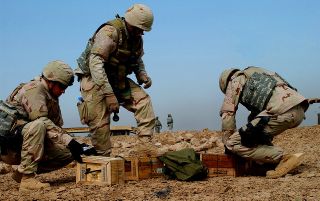Baghdad Blasts: Earthquake Detectors Map Sounds of War

Seismic equipment that was installed in Iraq to detect earthquakes has also recorded plenty of other big bangs — explosions from nearby mortars and car bombs. The individual "fingerprints" of these explosions could be used by experts to reconstruct these fast-paced incidents, and may even have real-time applications to help responders, according to a new study.
In Baghdad throughout 2006, the sound of bombs was common. But on the night of Oct. 10 of that year, when a mortar round struck the U.S. Forward Operating Base Falcon's ammunition supply depot, the explosive detonations that followed were, even for Baghdad, extraordinary, experts have said.
What happened at the ammunition depot, captured by onlookers on video, is referred to in the military as a "cook-off," when excessive heat causes ammunition to explode prematurely. The fires caused by the mortar strike triggered a series of explosions, which escalated quickly into a nightmarish scene of blazing fire and blast upon blast. In the new study, the researchers describe glowing fragments spewing into the air and mushroom-shaped clouds rising from the flames, which led some observers to suspect a nuclear attack. [The 10 Greatest Explosions Ever]
The researchers also reported that tremors shook the base, damaged nearby structures, and were felt by Baghdad residents to the north. Rounds were still exploding and fires burning well into the afternoon of Oct. 11, according to the news agency Stars and Stripes, which also mentioned that explosions at the depot "rattled windows" at another U.S. military installation, Camp Liberty, located near the Baghdad airport.
Other "ears" were picking up the blasts, too. Four miles (7 km) from the base, a seismometer, installed at the Baghdad Seismic Observatory to detect earthquakes, recorded every bang and boom. It was one of several seismometers that had only recently been installed to look at how the Earth's upper layer called the crust in the region could affect the frequency and magnitude of large quakes.
Ghassan I. Aleqabi, lead author of the new study, and his colleagues installed the Iraqi seismometers. After the fire and explosions rocked the depot in 2006, he and study co-author Michael Wysession wondered what the complex cacophony of violent blasts might have sounded like to their seismic equipment.
The equipment did not let them down. From the data recorded during the Oct. 10 explosions, the researchers were able to piece together sequences of events during that night, blast by blast, with certain types of explosions having distinct and recognizable "seismic fingerprints" that helped the scientists to identify them. [Wild Explosions on Video]
Sign up for the Live Science daily newsletter now
Get the world’s most fascinating discoveries delivered straight to your inbox.
Wysession, a professor of geophysics at Washington University in St. Louis, told Live Science that a single broadband seismometer like the one in Baghdad is designed to sample a range of frequencies. Seismometers visualize sounds as waves — the amplitude, or height of the wave, indicates how loud the sound is, while the frequency of the waves reveals how "high" or "low" the sound is, measured in hertz.
But how can a seismograph tell the difference between an earthquake and a bomb blast, let alone between types of man-made explosions?
"Think of your own ears," Wysession told Live Science. You can listen to an oboe and a clarinet, he said, and even if they're playing the same note, your ear can still tell which instrument is which. A seismograph can similarly distinguish between a mortar firing and a car bomb, "even though they both make a bang," he said.
According to Wysession, a characteristic of mortar blasts is that they peak at about 5 hertz. He and his colleagues were able to pinpoint when several mortar blasts happened during the incident by comparing matching seismic signatures that identified them, which differed from the seismic traces left by other types of explosions.
Sound wave amplitude, Wysession said, could also give an estimate of the distance of an explosion. "Obviously if a firecracker goes off and it's a mile away, it's going to have a very different sound than if it's right next to your ear," he said. And the same holds true for a seismograph, which records a different "picture" of sounds when they're farther away.
"Forensic seismology," as Wysession calls it, may seem like an unusual application for earthquake-detecting equipment, but it's actually not uncommon to find seismometers used for a wide range of scientific purposes.
"We track herds of caribou with seismometers," Wysession told Live Science. "We monitor ice cracking and glaciers' flow. You can look at noise levels in seismometers over decades to track how the intensity of storms has increased over decades due to global warming." In fact, he added, "Anything that makes a sound, you can use a seismometer for."
The findings were published Dec. 22 in the journal Bulletin of the Seismological Society of America.
Follow Mindy Weisberger on Twitter and Google+. Follow us @livescience, Facebook & Google+. Original article on Live Science.

Mindy Weisberger is an editor at Scholastic and a former Live Science channel editor and senior writer. She has reported on general science, covering climate change, paleontology, biology, and space. Mindy studied film at Columbia University; prior to Live Science she produced, wrote and directed media for the American Museum of Natural History in New York City. Her videos about dinosaurs, astrophysics, biodiversity and evolution appear in museums and science centers worldwide, earning awards such as the CINE Golden Eagle and the Communicator Award of Excellence. Her writing has also appeared in Scientific American, The Washington Post and How It Works Magazine.
